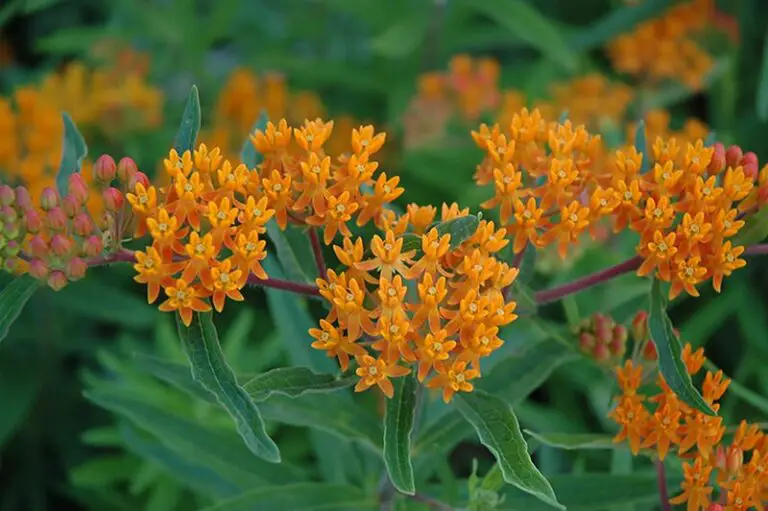The 23 Best Types Of Pothos Plants (With Names And Pictures)
Pothos plants are a popular choice for home decor, thanks to their ease of care and variety of colors. But did you know that there’s more to these plants than just their beauty? In this article, we’ll delve into the world of pothos plants, exploring the different types, how to identify them, and tips on how to care for them. From the vibrant green of the Cebu Blue Pothos to the unique variegation of the Harlequin Pothos, each type has its own distinct characteristics.
We’ll take a closer look at some of the most popular varieties, including the Baltic Blue, Dragon’s Tail, and Marble Queen. But pothos plants aren’t just about aesthetics – they’re also incredibly easy to care for. Whether you’re a seasoned plant parent or a beginner, these low-maintenance plants are perfect for anyone looking to add some greenery to their space. In addition to the basics of pothos plant care, we’ll also explore some creative ways to use these plants in your home décor.
From hanging baskets to trellises and more, we’ll show you how to bring out the best in your pothos. So, whether you’re a seasoned plant enthusiast or just starting out, this article is for anyone who wants to learn more about the wonderful world of pothos plants.
What is pothos?
Pothos, a stunning and low-maintenance houseplant, has the ability to instantly elevate any indoor space with its elegant charm. As a member of the Araceae family, native to the Solomon Islands, it shares a familial connection with philodendrons. The plant’s most distinctive features are its trailing vines and heart-shaped leaves that boast a luscious sheen.
What’s more, these leaves often display striking variegation patterns in shades of green, yellow, and white, adding an extra layer of visual appeal. Notably, pothos is a rapid grower, capable of reaching lengths of up to 20 feet if left unpruned. However, most cultivated specimens tend to be much smaller, typically maxing out at around three or four feet in length.
Pothos meaning and symbolism
Across various cultures, Pothos has gained significance for its perceived properties. It’s believed to attract good fortune and prosperity, while also serving as a symbol of fertility. Furthermore, in some cultural contexts, the plant is regarded as a safeguard against malevolent entities.
Pothos is often bestowed upon loved ones during milestone events like weddings or births, making it a thoughtful and meaningful gift.
Moreover, its versatility has led to its widespread use as decorative element in homes and offices, bringing a touch of natural elegance to any space.
How to identify pothos.
Pothos is a beloved houseplant due to its adaptability and low-maintenance requirements. However, even experienced pothos growers may struggle with plant identification at times. To accurately identify a pothos plant, start by examining the leaves, which typically take on heart-shaped or oval forms. The variegation patterns can range from subtle yellow or white highlights to striking cream-colored accents, serving as a distinguishing feature.
Beyond leaf morphology, inspect the stem for additional clues. Pothos stems are known for their trailing habit and can grow quite lengthy, often featuring a greenish-yellow hue. These stems tend to be slender, with either a smooth or slightly fuzzy texture. If you’re still uncertain about your plant’s identity, consider its floral displays. Pothos plants produce small, white clusters of blooms that lack a strong scent but are visually appealing nonetheless.
Types of Pothos Plants
Baltic Blue Pothos (Epipremnum pinnatum ‘Baltic Blue’)
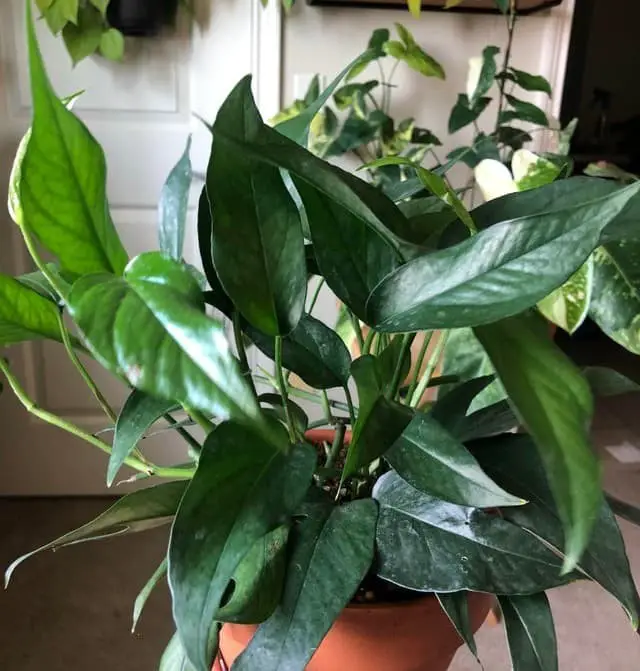
The Baltic blue pothos is a stunning cultivar of the Epipremnum pinnatum species, originating from the picturesque Mo’orea in the Society Islands of French Polynesia. This vigorous climber can grow up to 20 feet in length, making it an ideal choice for those looking to add some greenery to their space. One way to identify this beautiful plant is by its striking heart-shaped leaves, which boast a mesmerizing variegation featuring hues of green, yellow, and blue.
The small white flowers that bloom in clusters are another distinguishing feature. When it comes to caring for your Baltic blue pothos, you’ll be pleased to know that it’s a low-maintenance houseplant that can thrive in conditions with limited natural light. Propagation is also a breeze, as stem cuttings will yield new plants that can flourish in most potting soils. As with any plant, there are some potential drawbacks to consider.
For instance, the Baltic blue pothos is susceptible to mealybugs and spider mites, so it’s essential to keep an eye out for these unwanted visitors. Additionally, this plant is toxic if ingested, making it important to keep it out of reach from pets and curious little ones.
Cebu Blue Pothos (Epipremnum pinnatum ‘Cebu Blue’)
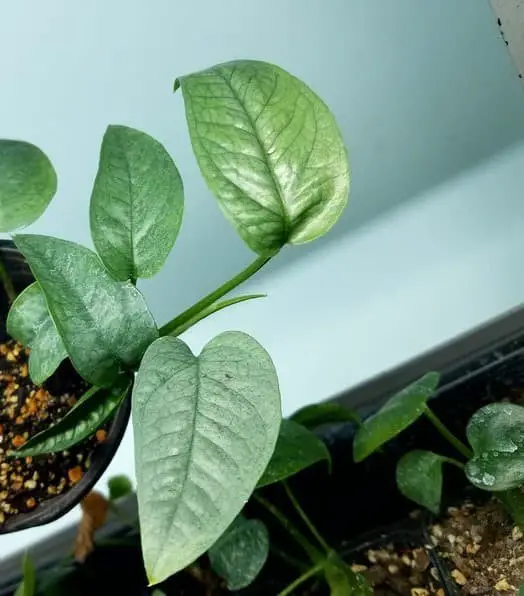
Cebu blue pothos is a stunning houseplant that boasts variegated leaves showcasing hues of green, blue, and silver. This easy-to-grow plant thrives in diverse conditions, making it an ideal choice for those new to plant parenthood. Native to the Philippines, specifically the island of Cebu, this species has spread to other parts of Southeast Asia and is now widely cultivated as a popular houseplant.
To care for your Cebu blue pothos, provide it with bright, indirect light, although it can adapt to low-light environments. Watering is straightforward – simply wait until the soil feels dry to the touch before giving it a drink.
One of the most significant advantages of having Cebu blue pothos in your home is its air-purifying properties. This plant has been shown to effectively remove harmful chemicals from the air, while also contributing to improved indoor air quality.
Dragon’s Tail Pothos (Epipremnum pinnatum)
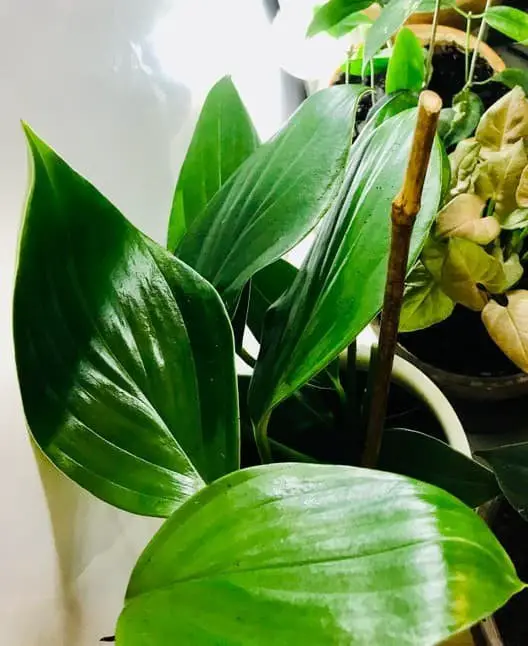
Dragon’s tail pothos, belonging to the Epipremnum genus, hails from southeastern Asia, with Malaysia, Thailand, and Indonesia being its native habitats. This evergreen vine can reach an impressive length of up to 30 feet, making it a striking addition to any indoor space.
The plant’s heart-shaped leaves boast a glossy appearance and exhibit variegation, featuring diverse color patterns.
The unique shape of the leaves, which grow in a dragon-like tail formation, inspired the plant’s common name. With its adaptability to low-light conditions and ease of care, it’s no wonder Dragon’s tail pothos is a favored houseplant among many.
To thrive, this plant requires moist, well-drained soil and monthly fertilization. However, due to its rapid growth rate, periodic trimming may be necessary to maintain the desired shape and size.
Emerald Pothos (Epipremnum aureum)
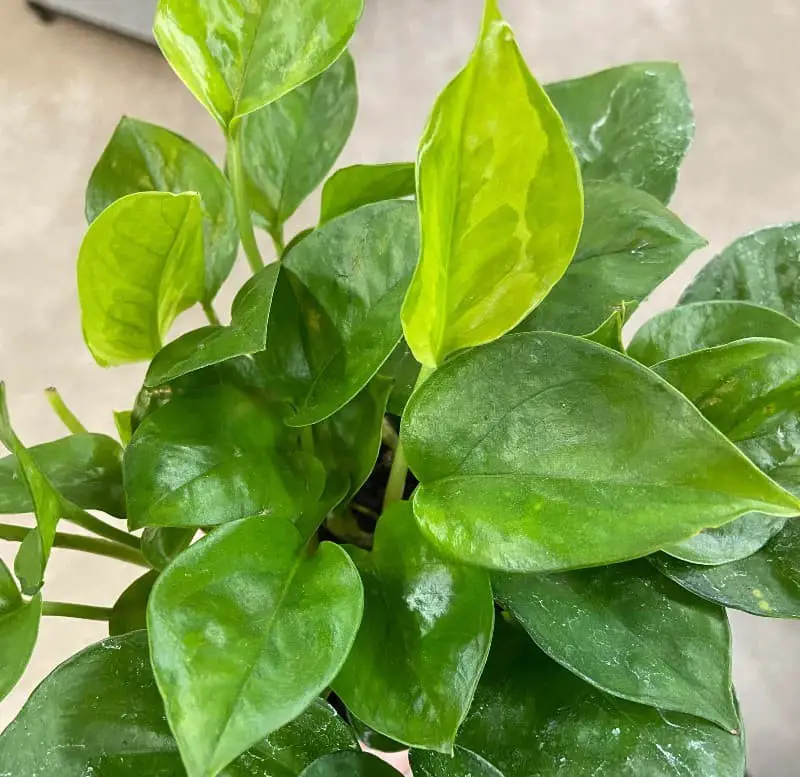
Emerald pothos, a species of flowering plant from the Araceae family, originates from Mo’orea in French Polynesia. This adaptable plant has naturalized itself in various regions around the world, including temperate zones, Puerto Rico, Florida, Hawaii, the Virgin Islands, Australia, India, South Africa, New Zealand, and Pacific and Indian Ocean islands. Its appearance varies across three main morphotypes that occur naturally.
First described by Austrian botanist Nikolaus Joseph von Jacquin in 1760 as Arum aureum, it was later reclassified to the Epipremnum genus by German-Dutch botanist Heinrich Wilhelm Schott in 1830. The Latin epithet aureum refers to the plant’s golden-yellow leaves.
Emerald pothos is a sought-after houseplant due to its ease of care and tolerance for neglect. It can grow up to 20 meters (66 feet) long, with individual leaves reaching lengths of up to 30 cm (12 inches).
However, it is not frost-tolerant and requires protection from temperatures below 15°C (59°F).
Propagation is relatively straightforward, as stem cuttings can be taken at any time of year and rooted either in soil or water. Emerald pothos is susceptible to various pests and diseases, including mealybugs, spider mites, scale insects, thrips, and root rot.
Glacier Pothos (Epipremnum aureum ‘Glacier’)

Glacier pothos is a fascinating species within the Araceae family, originating from Southeast Asia and parts of Australia. Its unique characteristic lies in its glossy, heart-shaped leaves that showcase a striking variegation in shades of white, yellow, or cream. This plant has the potential to grow up to 20 feet (six meters) in length, making it an ideal choice for indoor spaces as a houseplant or outdoor gardens in temperate climates.
One of its most appealing features is its ability to thrive in low-light conditions and tolerate poor soil quality. Additionally, glacier pothos is remarkably drought-tolerant, simplifying the process of maintaining this beautiful plant.
Global Green Pothos (Epipremnum aureum ‘Global Green’)
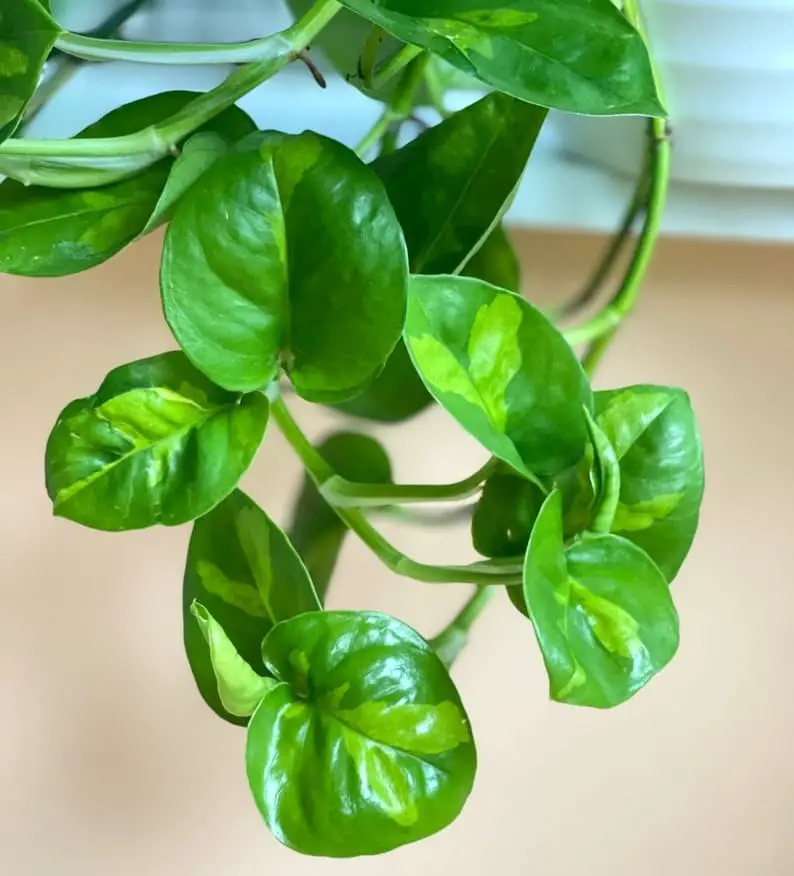
Global green pothos is a striking evergreen vine that originates from Mo’orea, an island in French Polynesia, belonging to the Araceae family. Its unique feature lies in its variegated leaves with heart shapes, boasting shades of green, yellow, and white. This adaptable plant can grow up to 20 feet long and is often used as a houseplant or garden addition. In terms of care, global green pothos is relatively low-maintenance.
It thrives under bright, indirect light but can also tolerate lower light conditions. To keep it healthy, allow the soil to dry out slightly between watering sessions, as over-watering can lead to root rot. Additionally, this plant is surprisingly resilient to temperature and humidity fluctuations.
Golden Pothos (Epipremnum aureum)
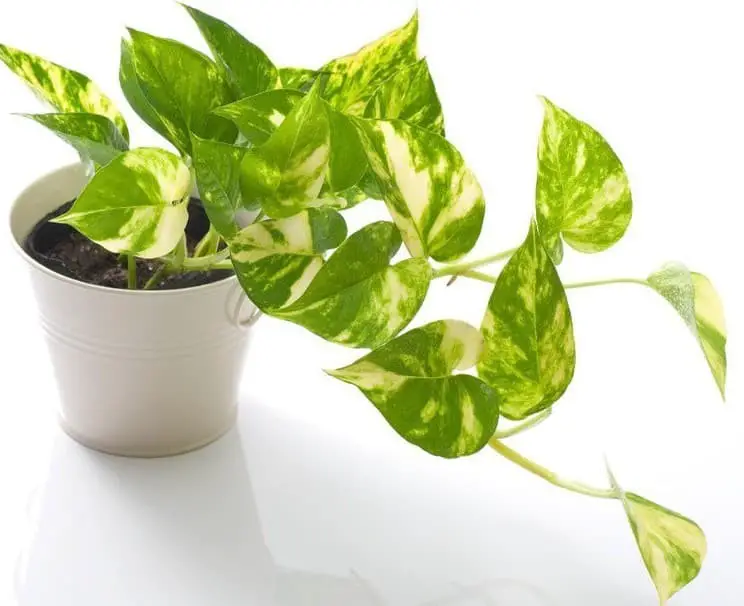
Golden pothos is a versatile trailing vine plant that has become a staple in many homes and offices. Its distinctive heart-shaped leaves feature striking golden or yellow variegations, making it a visually appealing addition to any space. One of the greatest advantages of golden pothos is its low-maintenance nature – it’s surprisingly easy to care for, even for those without a green thumb.
Additionally, this adaptable plant can thrive in environments with limited natural light, making it an excellent choice for rooms with limited sunlight.
Harlequin Pothos (Epipremnum aureum ‘Harlequin’)
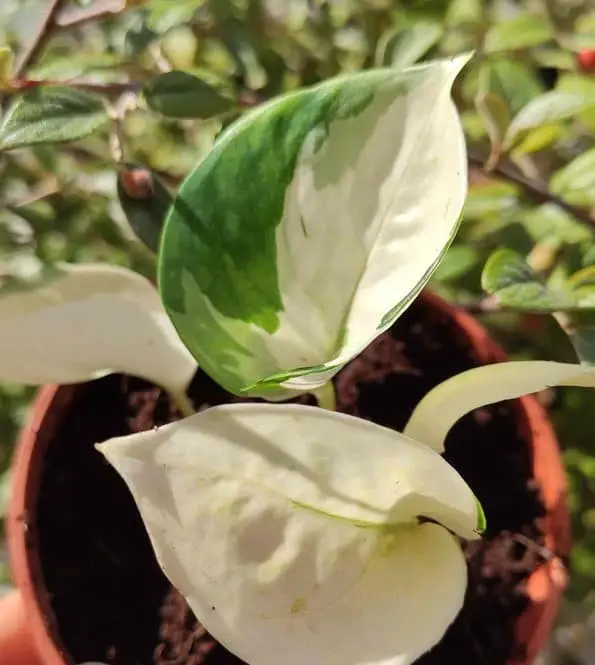
Harlequin pothos is a stunning type of pothos, characterized by its intricately patterned leaves that showcase a mix of green, white, yellow, and pink hues. Native to Southeast Asia’s tropical forests, this plant can be commonly found in countries like Thailand, Malaysia, and Indonesia. Its popularity as a houseplant lies in its low-maintenance nature, allowing it to flourish in a wide range of environments.
Dubbed the ‘devil’s ivy’ due to its remarkable ability to survive even the most neglectful of care, this plant has earned its reputation as an easy-to-grow and long-lasting addition to any indoor space.
Hawaiian Pothos (Epipremnum Aureum ‘Hawaiian’)
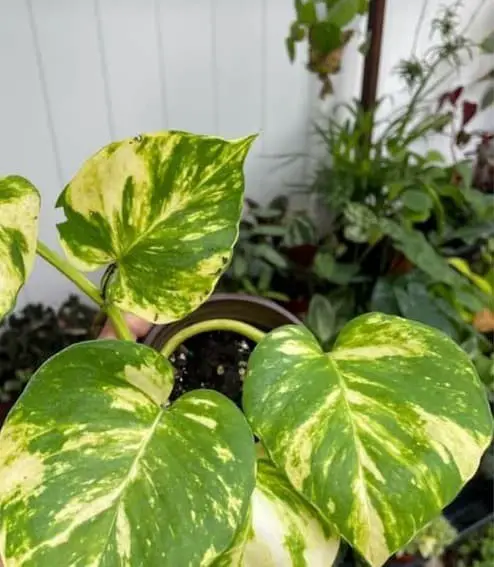
Hawaiian pothos, a tropical evergreen vine native to the Hawaiian islands, boasts striking features in its long, glossy leaves that display a mesmerizing variegation of yellow, white, or green hues. This versatile plant can grow up to 20 feet in length and thrives when provided with a trellis or other support to climb upon. Beyond its aesthetic appeal, Hawaiian pothos is also renowned for its low-maintenance nature.
It can thrive in low-light conditions and requires minimal watering, making it an ideal choice for busy homeowners or those new to plant parenthood. Additionally, the vine’s natural resistance to pests and diseases further simplifies its care, allowing you to focus on enjoying its beauty rather than worrying about potential issues.
Jade Pothos (Epipremnum aureum ‘Jade’)
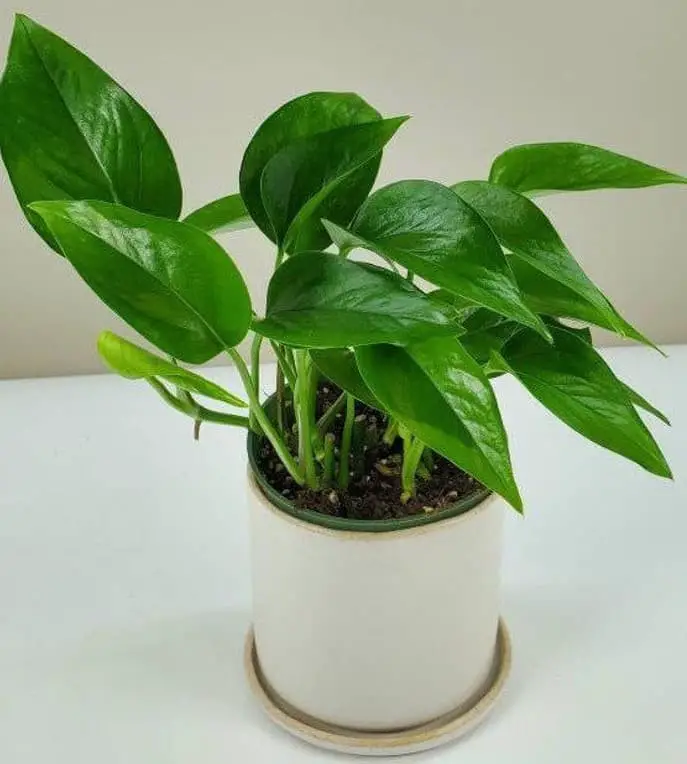
Jade pothos, a type of evergreen vine native to Southeast Asia, boasts an array of characteristics that have made it a beloved houseplant. Its leaves are heart-shaped and glossy, featuring variegated shades of green, yellow, and white, earning it the monikers golden pothos, Ceylon creeper, and hunter’s robe. This versatile plant has garnered popularity due to its ease of care and adaptability to a wide range of environments.
Furthermore, jade pothos is renowned for its air-purifying properties, making it an excellent choice for indoor spaces where clean air is paramount.
Jessenia Pothos (Epipremnum aureum ‘Jessenia’)

Jessenia pothos, a member of the Araceae family and subspecies of Epipremnum aureum, originates from French Polynesia. Its heart-shaped leaves showcase a striking combination of yellow and green hues. This climbing plant can grow up to 20 feet in length, thriving in humid and warm environments.
Caring for Jessenia pothos is relatively straightforward. It tolerates shade and requires minimal sunlight, making it an ideal choice for indoor spaces.
The plant prefers well-drained soil with a slightly acidic pH (6-7). Watering should occur only when the soil feels dry to the touch, while fertilization can be done every two weeks during its growing season.
As a fast-growing species, Jessenia pothos requires regular pruning to maintain its size and prevent invasion. Propagation is also possible through stem cuttings, making it a versatile addition to any plant collection.
Manjula Pothos (Epipremnum aureum ‘Manjula’)
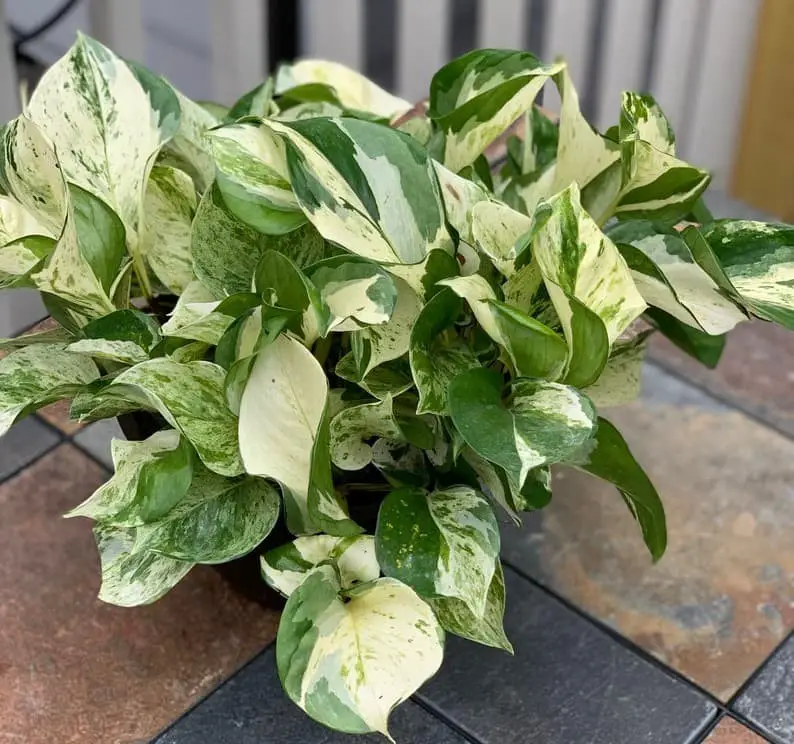
Manjula pothos, a lush and versatile vine, boasts remarkable adaptability and ease of care. Native to Southeast Asia and part of the Philodendron family, this fast-growing, evergreen plant can stretch up to 20 feet in length, making it an ideal choice for indoor spaces or tropical gardens. The leaves of Manjula pothos are characterized by their heart-shaped silhouette and striking variegated patterns, which add a touch of elegance to any setting.
Despite its impressive growth potential, this plant is remarkably low-maintenance, thriving in a wide range of conditions and requiring minimal care once established. Moreover, it can be easily propagated through stem cuttings and is resistant to common pests and diseases, making it an excellent choice for novice gardeners and seasoned horticulturists alike.
Marble Queen Pothos (Epipremnum aureum ‘Marble Queen’)
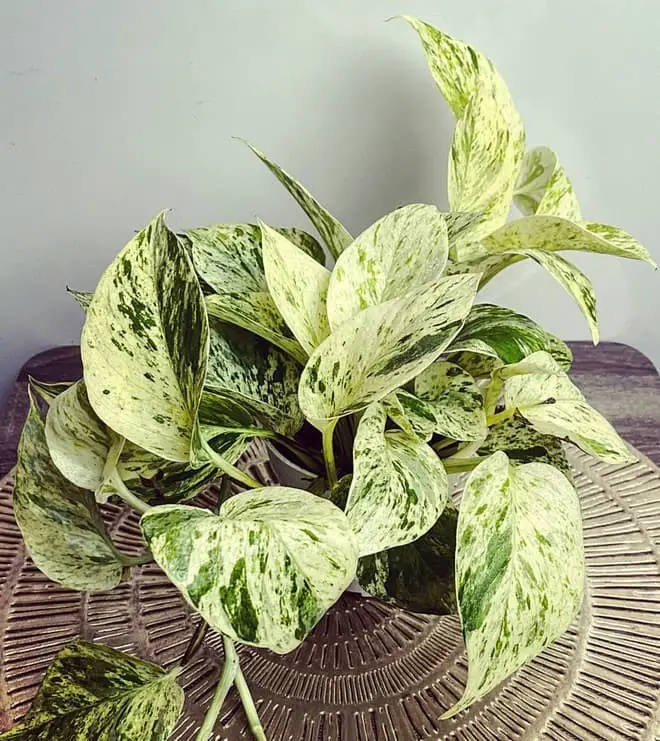
This stunning plant boasts a unique blend of colors that instantly elevates any room’s ambiance. Its low-maintenance requirements make it an ideal choice for busy homeowners or those new to plant parenthood. Characteristics that set the marble queen pothos apart include its striking leaves, which feature mesmerizing patterns of white and green hues.
One of its most notable features is its potential to grow quite large, making it perfect for filling in empty spaces and adding visual interest to a room.
Neon Pothos (Epipremnum aureum ‘Neon’)
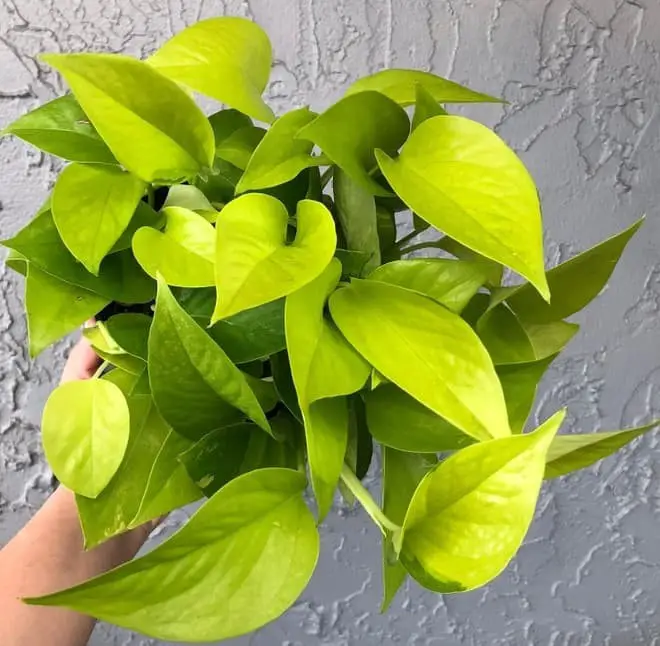
Neon pothos, specifically Epipremnum aureum ‘Neon’, has earned its reputation as one of the most sought-after houseplants due to its remarkable adaptability and low-maintenance requirements. Its striking variegated leaves, featuring a harmonious blend of green, yellow, and white hues, add an extra layer of visual appeal. The heart-shaped foliage can grow up to six feet in length, making it an excellent choice for trailing displays or vertical gardening.
What sets neon pothos apart from other houseplants is its exceptional ease of care, making it an ideal introduction to plant parenthood for beginners. It thrives in low-light conditions and can survive with infrequent watering, reducing the likelihood of overwatering-related issues. To keep your neon pothos happy and healthy, simply maintain a consistent moisture level in the soil and provide regular fertilization during the growing season.
Additionally, stem cuttings serve as a reliable method for propagating this versatile plant.
Njoy Pothos (Epipremnum aureum ‘NJoy’)
Njoy pothos, also known as Epipremnum aureum ‘NJoy’, is a cultivar of the golden pothos, devil’s ivy, or money plant. This variegated beauty boasts creamy yellow and green margins on its leaves, making it a popular choice for its aesthetic appeal and versatility. Native to the Solomon Islands, Njoy pothos has since been widely cultivated in tropical and subtropical regions worldwide. It thrives in forests, on trees, and as a groundcover in shady areas.
To care for Njoy pothos, start by providing it with bright, indirect light – although it can adapt to low-light conditions if needed. Water when the soil feels dry to the touch, and consider monthly fertilization during the growing season. One of its most impressive features is its tolerance for a broad range of temperatures, making it an excellent choice for those living in cooler climates. With these simple care instructions, even novice gardeners can enjoy the beauty of Njoy pothos.
Pearls and Jade Pothos (Epipremnum aureum ‘Pearls and Jade’)
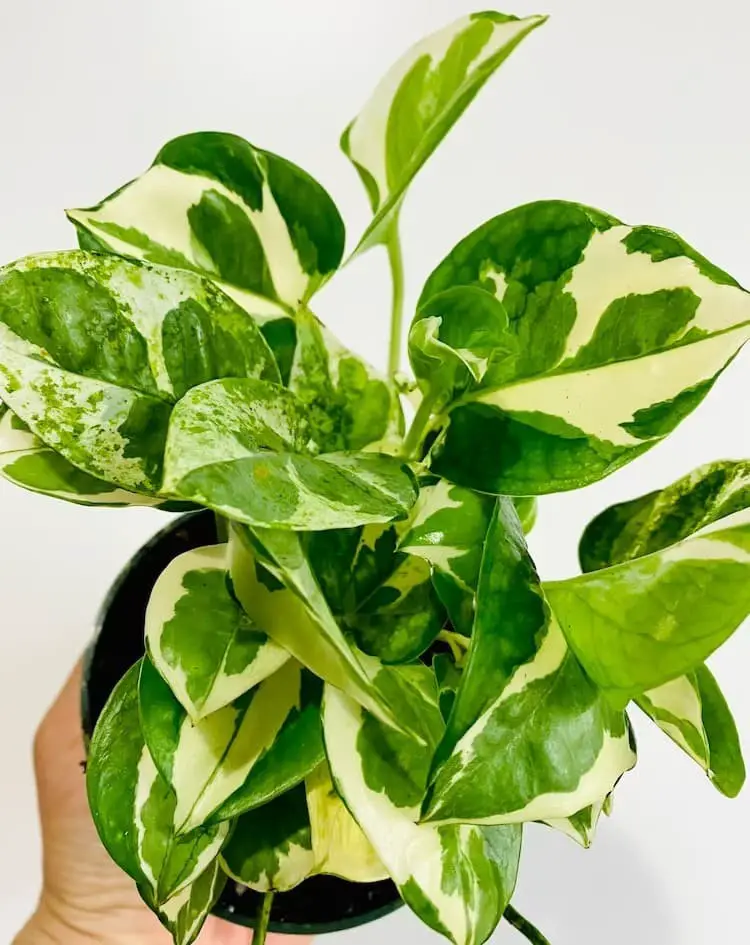
Pearls and Jade pothos is an alluring addition to any space, boasting the ideal blend of ease of care and stunning visuals. This versatile trailing houseplant can grow up to six feet in length, featuring heart-shaped leaves with a mesmerizing combination of green, white, and yellow hues. With its rapid growth rate, it’s no wonder Pearls and Jade pothos is a popular choice for those new to plant parenthood, as well as seasoned collectors alike.
Satin Pothos (Scindapsus pictus ‘Argyraeus’)
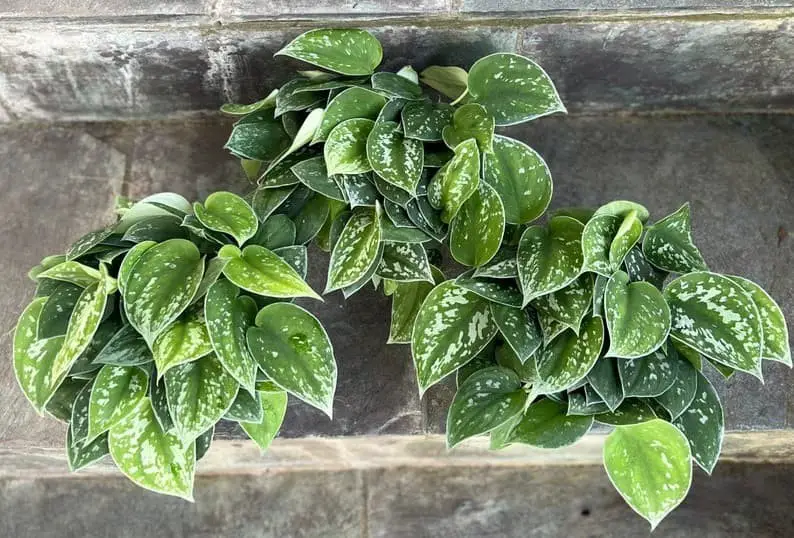
Satin pothos is a stunning houseplant that effortlessly adds a touch of elegance to any room. Also known as silver pothos or variegated philodendron, this versatile plant is perfect for both seasoned and novice gardeners alike.
What sets satin pothos apart from other plants is its remarkable ability to thrive in low-light conditions and withstand occasional neglect when it comes to watering. This forgiving nature makes it an excellent choice for those new to houseplant care.
So, what exactly defines this beautiful plant? Satin pothos boasts heart-shaped leaves that display a mesmerizing blend of silver and green hues, giving them a glossy sheen reminiscent of satin fabric. The vines of this climbing plant can grow up to 20 feet in length, making it an ideal candidate for hanging baskets or trailing over shelves, adding a whimsical touch to any room’s décor.
Shangri La Pothos (Epipremnum Aureum ‘Shangri La’)
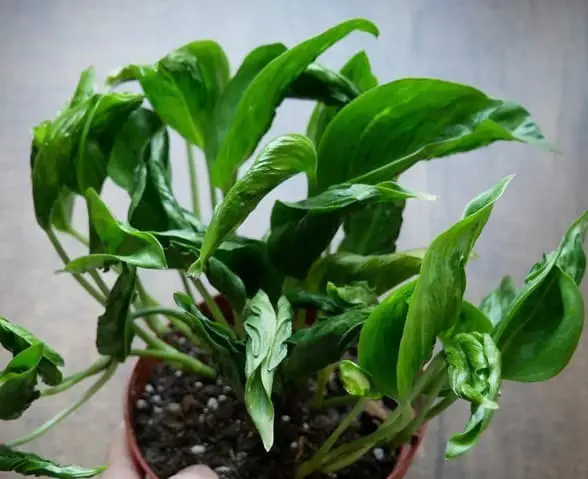
Shangri-La Pothos, also known as the ‘Golden Pothos’ or ‘Neon Pothos’, is an evergreen vine that belongs to the Araceae family. Native to Mo’orea, an island in French Polynesia, this plant boasts a unique feature set. Its glossy, heart-shaped leaves are variegated with shades of green, yellow, and white, growing up to 12 inches in length. As a fast-growing species, Shangri-La Pothos can reach lengths of up to 20 feet when mature.
Its ease of care and adaptability to various conditions have made it a popular choice for indoor cultivation.
Silver Satin Pothos (Scindapsus pictus ‘Exotica’)
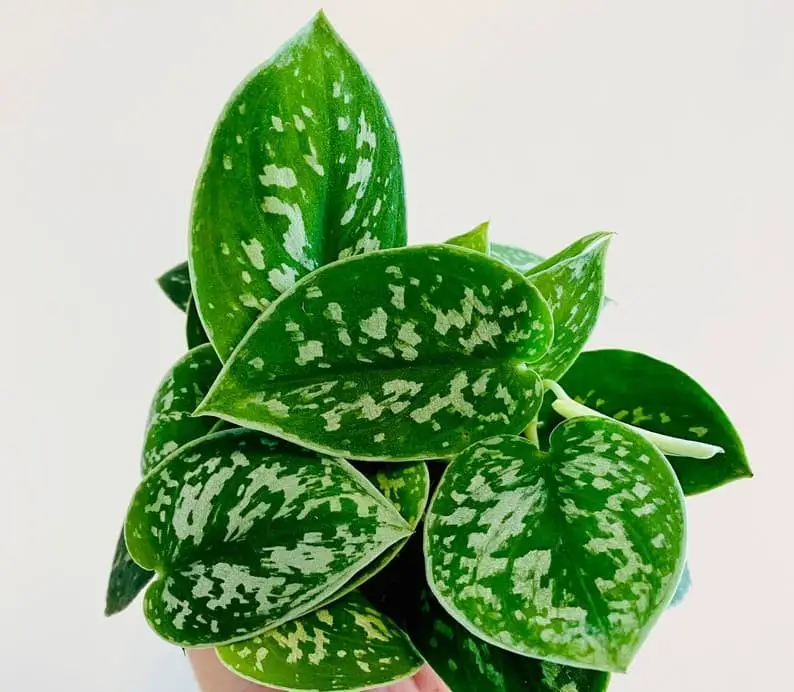
Silver satin pothos is a stunning variety of the popular Pothos species, distinguished by its striking variegated leaves featuring large silver patches on a predominantly green background. This evergreen climber can reach impressive lengths of up to 20 feet, making it an excellent choice for those seeking a versatile houseplant.
Native to Malaysia, Indonesia, and the Philippines, Silver satin pothos has been successfully introduced to many other regions.
Its rapid growth rate allows it to thrive in a variety of settings, including pots, hanging baskets, or as a groundcover. This adaptable plant requires minimal maintenance, tolerating diverse light conditions while preferring bright, indirect illumination.
When it comes to watering, Silver satin pothos is forgiving, requiring soil that’s only dry to the touch before being replenished. In fact, allowing the soil to fully dry out between waterings can help prevent overwatering.
Notably, this plant poses no threat to pets or humans, making it a safe addition to any home.
One caveat: Silver satin pothos has a tendency to grow aggressively, so regular trimming is necessary to keep it from overwhelming its surroundings. With proper care and attention, however, this beautiful plant can bring joy and freshness to any space.
Skeleton Key Pothos (Epipremnum Pinnatum ‘Skeleton Key’)
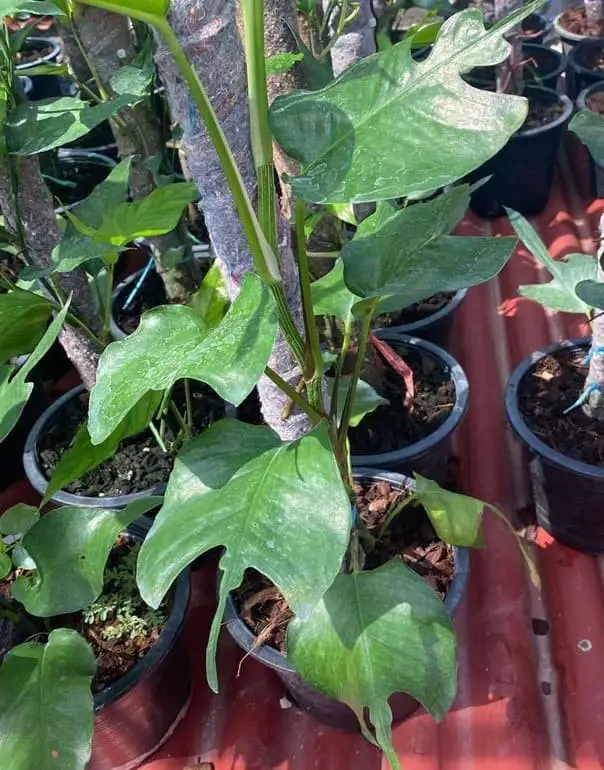
Skeleton Key Pothos is a unique variety that stands out from its more leafy counterparts due to its minimal foliage. This characteristic makes it an ideal choice for those seeking a clean, modern aesthetic in their living spaces. Additionally, Skeleton Key Pothos is a great option for beginners, as it requires little effort and attention to thrive. With its slender stems and small, oval-shaped leaves boasting a glossy finish, this plant offers a touch of elegance and sophistication to any room.
Characteristics that set Skeleton Key Pothos apart include the diminutive size of its leaves, which are typically a deep green hue but can also feature variegation in shades of white or yellow. The stems themselves are slender and slightly curved, adding an organic touch to this already charming plant.
Snow Queen Pothos (Epipremnum aureum ‘Snow Queen’)
Snow Queen Pothos is a stunning variety of Pothos plants that stands out with its striking, variegated foliage. The leaves are predominantly white, punctuated by vibrant green spots or streaks, giving them a mesmerizing silvery sheen. As an incredibly low-maintenance plant, Snow Queen Pothos proves to be an excellent choice for indoor spaces, making it an ideal addition to any home or office decor.
Trebi Pothos (Scindapsus Pictus ‘Trebi’)
Trebi pothos, a member of the Scindapsus genus, is an evergreen climbing vine native to Southeast Asia’s tropical forests. Its impressive length can reach up to 20 meters, showcasing heart-shaped leaves with intricate patterns of green, yellow, and white hues. Also known as silver pothos, this plant has gained popularity as a low-maintenance houseplant capable of thriving in low-light conditions.
Moreover, trebi pothos is renowned for its air-purifying properties, effectively removing harmful toxins like formaldehyde and benzene from the surrounding environment.
Variegated Neon Pothos (Epipremnum aureum ‘Neon Variegata’)
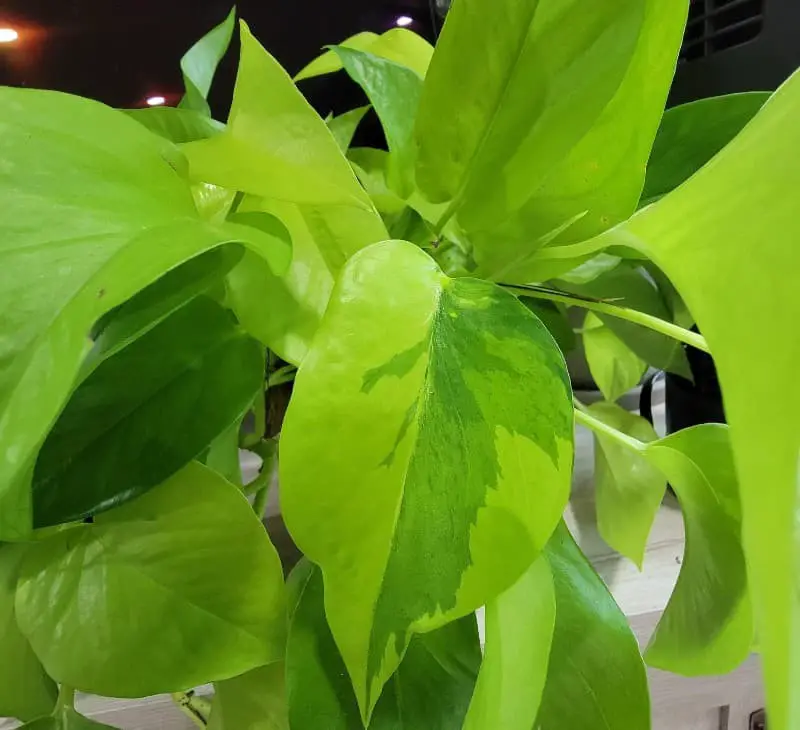
Variegated neon pothos is a stunning indoor plant renowned for its striking leaves, which exhibit an intricate pattern of green, yellow, and white hues. This versatile houseplant can grow quite substantial, making it an ideal choice for filling empty spaces or adding a touch of natural beauty to any room.
Caring for variegated neon pothos is remarkably straightforward. Its adaptability allows it to thrive in environments with minimal water and light requirements.
In fact, it can even tolerate low-light conditions, making it an excellent option for rooms with limited natural illumination.
To keep your variegated neon pothos thriving, simply water it once a week and fertilize it monthly. If you notice the leaves beginning to turn yellow, it’s likely a sign that the plant is craving more moisture.
FAQs about Pothos Plants
What is the rarest type of pothos?
While there are numerous varieties of pothos, the elusive golden pothos stands out as the rarest and most sought after. This enigmatic plant is notoriously hard to come by, typically only available through select specialty nurseries. Its unique characteristic lies in its variegated leaves that seamlessly blend shades of yellow and green, rendering it a breathtakingly beautiful specimen.
For those fortunate enough to stumble upon this gem, it’s crucial to provide the necessary TLC to ensure its continued health and vibrancy.
What is the difference between Jade pothos and golden pothos?
While sharing some similarities, the Jade Pothos and Golden Pothos exhibit distinct characteristics that set them apart from one another. Notably, their leaves showcase unique patterns: the Jade Pothos features dark green leaves with white variegation in a heart-shaped design, whereas the Golden Pothos boasts heart-shaped leaves with a variegated pattern of yellow and green. Both plants are well-suited for home environments due to their ease of care.
Nevertheless, there are some notable differences between them. The Jade Pothos is a rapidly growing plant that can stretch up to 20 feet in length, whereas the Golden Pothos grows at a slower rate, typically reaching a maximum height of around six feet. In terms of lighting requirements, the Jade Pothos demands more intense illumination compared to its golden counterpart.
As for care and maintenance, both plants are relatively low-maintenance, but the Jade Pothos proves more resilient in the face of neglect. Additionally, the Golden Pothos exhibits greater resistance to pests and diseases.
Is the pothos snow queen rare?
In the lush tropics of Asia, the Pothos Snow Queen thrives as a stunning, yet elusive, plant species. This evergreen climber has a remarkable ability to stretch up to 30 feet in length, its slender stems weaving a verdant canopy. But what makes it truly unique is its breathtaking display of white, fragrant flowers, wafting a sweet scent that’s simply irresistible.
Is there a difference between snow Queen and marble Queen pothos?
While Snow Queen Pothos and Marble Queen Pothos may share some superficial similarities, they exhibit distinct characteristics upon closer examination. A primary difference lies in their leaf coloration: Snow Queen Pothos boasts predominantly white or pale green foliage, whereas Marble Queen Pothos displays a variegated pattern featuring green, white, and yellow hues. Moreover, Snow Queen Pothos tends to be more compact than its Marble Queen counterpart.
Additionally, while both plants are generally low-maintenance, Snow Queen Pothos is reportedly more demanding in terms of care.
What is the difference between NJoy and pearls and jade pothos?
While appearance-wise, NJoy exhibits a sleeker and more refined aesthetic, pearls and jade pothos boast a more organic, natural charm. In terms of maintenance, both types are relatively low-maintenance, though pearls and jade pothos might require slightly more attention when it comes to watering and fertilizing. On the financial front, NJoy tends to be pricier than its pearl and jade counterparts.
Ultimately, the most suitable plant for you will hinge on your personal inclinations regarding appearance and care.
Can I plant different types of pothos together?
Pothos are surprisingly accommodating when it comes to co-planting with other varieties. In fact, they’re not finicky at all and can thrive alongside most other plants, as long as each one has sufficient space to grow. Overcrowding can lead to unwanted visitors like disease and pests, so it’s always a good idea to err on the side of caution when combining multiple pothos species.
The payoff is well worth the effort, though – different types of pothos can create stunning displays with their diverse array of colors and patterns. If you’re unsure which combinations will work best for your space, consult with local nursery or garden center experts for personalized recommendations. With a bit of trial and error, you’ll soon find the perfect harmony of plants to bring joy and beauty to your home.
Conclusion
Among the numerous varieties of pothos plants, each boasts its distinct characteristics and advantages. Whether you’re seeking a hassle-free addition to brighten up your living or working space, or aiming to cultivate a more demanding yet rewarding species to enhance air quality, there’s an ideal pothos plant waiting for you. So, what are you waiting for? Begin building your pothos collection today!
If you have a preferred type of pothos plant, feel free to share your experience in the comments below. Additionally, don’t forget to explore our other blog posts for more insights on plants and gardening.
Related Posts
To embark on a career as a plant breeder, follow this step-by-step guide. The process begins with earning a Bachelor’s degree in horticulture, botany, or a related field. Gain hands-on experience through internships and volunteer work at botanical gardens, nurseries, or plant breeding companies. Pursue a graduate degree for advanced knowledge and networking opportunities. Develop skills in areas such as crop improvement, genetics, and statistical analysis.
Consider obtaining certifications like the American Society of Horticultural Science’s (ASHS) Certified Horticulturalist credential. Build a strong network by attending conferences, seminars, and workshops to stay updated on industry developments and best practices. Join professional organizations like the ASHS or the International Plant Breeding Committee to access resources, research opportunities, and job listings.
As you progress in your career, focus on developing expertise in specific plant species, varieties, or breeding techniques. This can lead to opportunities for consulting, teaching, or even starting your own plant breeding business.

